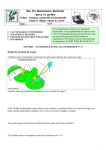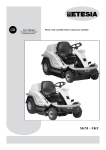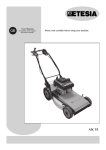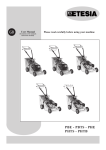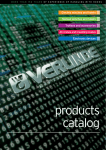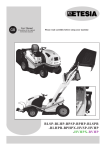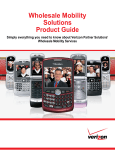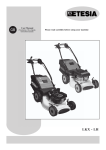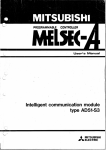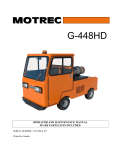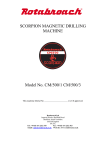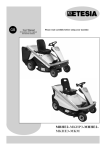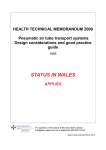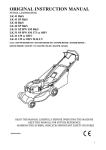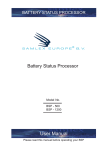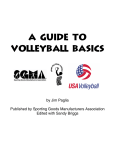Download Etesia AV95 AV98 AV98X Ride on brushcutter mower owners
Transcript
GB User Manual (Translation of the originals instructions manual) Please read carefully before using your machine AV95-AV98-AV98X CONTENTS 1. Your safety and that of others ....................................................................................................................................................... 3 2. Key to diagrams ............................................................................................................................................................................ 5 3. Description .................................................................................................................................................................................... 9 4. Pictures ....................................................................................................................................................................................... 10 5. Technical specifications .............................................................................................................................................................. 13 6. HST oil replacement AV98X ...................................................................................................................................................... 14 7. Operating instructions ................................................................................................................................................................. 16 8. Maintenance ................................................................................................................................................................................ 18 9. Cleaning ...................................................................................................................................................................................... 21 10. Machine lubrication points ......................................................................................................................................................... 21 11. Maintenance schedule ................................................................................................................................................................. 22 12. Prolonged storage - winter storage ............................................................................................................................................. 23 13. Troubleshooting .......................................................................................................................................................................... 23 14. Warranty...................................................................................................................................................................................... 24 C ONGRATULATIONS ! You are now the proud owner of an Etesia ride-on brush-cutter. This extremely reliable and tough machine has been specially designed to give many years of service. • In order to prolong the life of your mower and keep it in excellent working order, read this manual carefully and always follow the safety recommendations and maintenance instructions. • As part of our commitment to excellence, we are constantly seeking new ways of improving our products. • For this reason, your model may differ slightly from the description in this manual. • Up-to-date technical information can be obtained from your dealer. • He will be happy to resolve any queries you may have. MOWER IDENTIFICATION • The identification number of your ride-on brush-cutter is located on the central bonnet in front of the seat. • Always quote this number when seeking advice from your dealer. 1• YOUR SAFETY AND THAT OF OTHERS • Always follow these instructions when using your ride-on brushcutter. • No responsibility will be accepted by the manufacturer in the event of failure to comply with this manual or with current regulations. • Prior to use, check that safety labels are present on the ride-on brush-cutter as indicated in the manual. Read these labels carefully. If any safety labels are missing, inform your dealer immediately, as the ride-on brush-cutter is required by law to carry them. • Never remove warning labels or safety instructions. • Before using your ride-on brush-cutter, make sure that you are completely familiar with the controls. • Study the operating instructions so that you are able to stop the machine quickly. • Always keep the ride-on brush cutter and accessories in good working order. • Replace the worn or damaged parts for more safety. • Never operate the mower using faulty guards or without the use of safety devices. • Never attempt to adjust your ride-on brush cutter without the prior approval of the manufacturer. • Unauthorized adjustments could be dangerous and result in serious injury to the user. No responsibility will be accepted by the manufacturer in the case of failure to comply with these instructions. • Do not attempt to adjust the engine speed controls. • Overspeeding the engine increases the risk of injury to the user. • Never allow your ride-on brush cutter to be used by anyone who is not familiar with the operating manual. • Never use your ride-on brush cutter on slopes with a gradient of more than 17° (30%). • Always observe the special instructions concerning use of the rideon brush cutter on sloping ground. • Never drive your ride-on brush cutter too close to embankments or ditches, on soft ground, or where there is a risk of overturning. • The user is responsible for ensuring the safety of others within the area where the ride-on brush-cutter is being used. • Keep a safe distance from people and animals when the engine is running. • Never allow passengers come on the ride-on brush cutter. • Never allow children under the age of 16 to drive the ride-on brushcutter. • Always remove the ignition key when leaving the ride-on brush cutter unattended, even momentarily. • Disengage the drive mechanisms and accessories for transport or when they’re not used. • Before using the ride-on brush cutter, always check the condition and adjustment the blade. • Never attempt to carry out work on or underneath the ride-on brush cutter if it has been raised on temporary supports or without taking proper safety precautions. • Before mowing, always clear the field of stones, pieces of wood or metal, wire, bones, plastic, branches and other debris liable to be thrown out by the ride-on brush cutter. • Disengage the cutting system, stop the engine and take the switch key away in following cases : - Before taking a grass padding away. - After you hurted a object in order to look at eventuel damages and to repair if necessary. - If the machine begins to vibrate not normaly in order to look for causes. - If the blade is blocked (blade clutch out of order). • Never ask anybody else to check the possible damages or to puch the ride-on brush cutter while the driver is on the seat. • Make sure that your lawn has no natural barriers of the type molehills, cracks, ruts... • Low branches liable to cause injury to the user should also be removed. • Avoid obstacles such as mole hills, concrete pedestals, tree stumps and edging, which cannot be cut by the blade and which could damage the cutting mechanism specially the blade and the transmission. • Exercise particular care when reversing. • Never place hands or feet under the cutter housing. • Whilst mowing, take care to avoid injury to others caused by flying stones and other objects. • Operate the ride-on brush-cutter only in broad daylight or with good artificial lighting. • The front light fitted on the ride-on brush-cutter has not been designed to work in the night. This light is not powerfull enough to show the dangers. • Ride-on brush-cutter may not be driven on public highways. • Loose clothing and short trousers should not be worn when using the ride-on brush cutter. • Always wear stout and closed shoes. • When adjusting the engine or moving parts, always switch off the engine and remove the ignition key and disconnect the spark plug lead. • Never operate the machine when feeling tired or unwell. • Never operate the machine after consuming alcohol or taking medicine. • When the mower is driven out of the field, disengage the cutter and switch it to the fully raised position. • Do not fill the fuel tank whilst the engine is running. Allow the engine to cool for few minutes before filling. • WARNING: fuel is highly flammable. - Fuel should be stored in clean containers specially designed for this purpose. - Always fill the fuel tank outdoor and do not smoke during this operation. - Add fuel before starting the engine. 3 1• YOUR SAFETY AND THAT OF OTHERS Never remove the fuel cap whilst the engine is running or hot. - If fuel is spilt, do not start the engine: remove the mower from the affected area and take care not to ignite any undispersed fuel vapour. • Ensure that the fuel tank and fuel can caps are replaced correctly. • Never store, or use petrol near a flame or near devices such as stoves, water-heaters with pilot lights or any other device liable to produce sparks. • These recommandations are also available for the ride-on brush cutter. • WARNING: NEVER ALLOW THE ENGINE TO RUN IN CONFINED AREAS. Exhaust gas contain carbon monoxide, which is odourless and can kill. • Let cool the engine before you park the ride-on brush cutter. • Do not start the engine if you can smell petrol, or in the presence of other explosion risks. 4 • Do not run the engine without a silencer. • Clean regulary the exhaust, the engine, the battery compartment, and the periphery of the fuel tank in order to avoid accumulation of flammable materials (grass, leaves, grease excess, etc). • These precautions are vital to your safety. However, the recommendations given are not exhaustive and due care should always be exercised when using your ride-on brush cutter. • You should also comply with any legal requirements relating to ride-on brush cutter (e.g. insurance, useful life, etc). • The ride on brush cutter is not designed to tow a charge. • The under pressure hydraulic oil is dangerous because it can, when it is a microjet (leak), penetrate the skin and lead to serious injury. A medical assistance is immediately needed. 2• KEY TO DIAGRAMS - SAFETY • LABELS DIAGRAMS RECTANGLE C • Various labels have been affixed to your ride-on brush-cutter. • Check that they are all present (see list below and pictures). • Labels with a yellow background warn against risks. • The other labels contain instructions for operating the ride-on brushcutter. • a = Risk of cuts to feet and hands. This symbol appears in the instruction manual alongside those sections which deal with user safety. This symbol appears in the instruction manual alongside important information on how to prolong the life of your ride-on brush-cutter. • ENGINE DIAGRAMS Fuel is highly explosive and inflammable. Stop the engine before fill the fuel tank. DO NOT SMOKE. Always fill the fuel tank in the open and never pour or use petrol near a naked flame or near devices such as stoves, water-heaters with pilots lights or any other deviceiable to produce sparks. Exhaust fumes are very toxic and contain carbone monoxide who is a deadly and odourless poison. Do not run the engine in confined areas. To avoid any burn, do not touch the exhaust pipe when it is hot. • SAFETY LABELS DIAGRAMS RECTANGLE A • 1 = Risk of injury to feet and hands. • 2 = Keep third persons far from the machine. • b = Keep third persons far from the machine. • c = Risk of thrown objects and injury to feet. • d = Never drive the brush-cutter without the deflector. Never open the deflector by running engine. Before each use, check that the deflector is in place. DIAGRAMS RECTANGLE D • a = CAUTION ! DANGER • b = Before using, please read and follow the safety and maintenance instructions of the instruction booklet. • c = Stop the engine, disconnect the spark plug before proceeding and remove key from ignition. • d = Risk of thrown objects. • e = Avoid the presence of third persons in the danger zone. • f = Risk of tripping. • g = Never transport passengers. Hold the third persons far from the machine. • h = Risk of toppling over the machine. • i = Never use your ride on mower on slopes with a gradient of more than 30% (17°). MARKING OF ACCUMULATORS • a = Indicates that these hazardous products which should preferably be returned to the distributor. • b = (Pb) indicates the presence of lead. • c = Indicates the year of entry into service onthe machine. DIAGRAMS RECTANGLE B • 3 = Risk of body injury. • 4 = Never open or take the side flap off. Stop the engine and remove the key from ignition before proceeding. See the instruction manual. 5 2• KEY TO DIAGRAMS - SAFETY Rectangle D Rectangle B 3 4 1 1 2 Rectangle A RectangleC 6 2• KEY TO DIAGRAMS - SAFETY Rectangle A 1 2 Rectangle B 4 Rectangle C a b Rectangle D 3 Marking of accumulators c 7 2• KEY TO DIAGRAMS - USE AV 98 X MODEL AV 98 AV 95 Indications for controlling engine speed : Engine speed MAXI : engine at full speed MINI : engine idling F : Max. forward speed N : Neutral position (Brush-cutter stop) R : Max. reverse speed Transmission 0 : engine off, power switched off I O Starting the engine 12 1 : power switched on 1 13 : engine started AV95 / AV98 AV98X The arrow indicates handle movement to engage differential lock Differential lock Low speed Neutral START Starter High speed Position for cold start 13118 Parking brake The arrow indicates the direction of movement of the brake pedal in order to engage the parking brake. 1 2 13113 AV95 AV98 Indicates the cutting height in mm (measured on hard, flat ground) The arrow indicates handle movement to engage the cutter AV98X : Cutter switched on : Cutter switched off Grease point 13256 13121 1 2 31 13271 13255 I O 13257 1 13113 13380 1 2 13113 13118 START 13118 8 13260 3• DESCRIPTION 13 14 18 15 17 16 19 20 1 8 9 21 2 12 3 10 11 4 5 6 7 2 • 1. Seat • 2. Speed selector (AV95 - AV98) • 3. Differentiel lock lever • 4. Drive level • 5. Deflector • 6. Throttle lever • 7. Drive pedal (AV98 - AV98X) • 8. Steering wheel • 9. Fuel level indicator • 10. Light switch • 11. Ignition switch • 12. Choke • 13. Cutting height lever • 14. Fuel tank cap • 15. Blade clutch lever • 16. Engine cover • 17. Fuel tank • 18. Brake pedal lock • 19. Brake pedal • 20. Fuel cock • 21. Engine oil pressure indication (AV98 - AV98X) 9 4• PICTURES a 4 b 3 6 5 7 10 8 4• PICTURES 10 9 11 12 Exchange! 14 13 7 1 3 2 1 27169 Nut M14 2 27170 Was Washer 3 27266 Spacer 6 4 34190 Blade body 8 5 27166 Screw 6 4 5 Blade 7 MC85 Blade + Bolting 8 27543 Fixing Kit MC85 15 11 4• PICTURES A 16 18 b 17 a 20 19 a 21 12 5• TECHNICAL SPECIFICATIONS c AV 95 b : 945 b : 970 b a AV 98 b : 945 AV 98 X MODEL a : 1080 a : 1080 c : 1950 c : 1900 a : 1070 c : 1900 ENGINE Type Bore x stroke Cubic capacity Power Lubrication Fuel type Cooling Starter motor Alternator Battery Spark plug Spark gap Ignition Petrol filter Air filter Rate BRIGGS & STRATTON 4 stroke - vertical shaft - tilted (OHV) 75.5 x 70 mm 72 x 70 mm 627 cm3 570 cm3 23 hp (17.1 kW) at 3600 rpm-1 21 hp (15.4 kW) at 3600 rpm-1 18 hp (13.2 kW) at 3600 rpm-1 By oil pressure Unleaded petrol Air cooling by forced ventilation 12 V electrical starter 12 V - 16 A with regulator 12 V - 3 A with regulator 12 V - 16 A with regulator 12 V - 60 A 12 V - 30 A Ø 14 x 19 mm, base : 16 mm 0.76 mm Electronic Metal filter 75 µm Paper cartridge with foam pre-filter Operation at 3300 rpm Oil sump capacity 1.36 l + 0.2 l with oil filter 1.5 l + 0.2 l with oil filter Petrol tank capacity 1.4 l + 0.3 l with oil filter 14 l with level indicator RIDE-ON BRUSH-CUTTER Weight Cutting width Blade housing Cutting height 342 kg 295,5 kg 97.5 cm, single blade Steel 2 mm 8 positions : from 50 to 125 mm + 1 transport position Blade clutch Safety systems Ejection Frame design Transmission Speeds fast Forward Gear : 0 - 10 km/h Reverse Gear : 0 - 8 km/h Speeds slow Parking brake Tyre sizes Tyre pressure Widht Distance between wheels Ray of not mowed surface Blade Sound pressure at driver’s seat 310 kg 95 cm, single blade Front : 4.00 x 7.0 Rear : 17 x 8.00-8 Front : 920 mm - Rear : 1000 mm 1320 mm 0.8 mm 88,3 dB(A) 8 positions : from 50 to 120 mm + 1 transport position Mechanical Conductorswitch Side + Rear Mechanically welded, multitubular structure Hydrostatic with differentiel lock Forward Gear : 0 - 10 km/h Forward Gear : 0 - 11 km/h Reverse Gear : 0 - 3.5 km/h Reverse Gear : 0 - 6.2 km/h Forward Gear : 0 - 6.5 km/h Forward Gear : 0 - 5 km/h Reverse Gear : 0 - 2.5 km/h Reverse Gear : 0 - 2.8 km/h Mechanical Front : 3.5 x 8.0 Rear : 17 x 8.0 Front : 1.2 bar - Rear : 1.0 bar Front: 910 mm - Rear: 985 mm 1260 mm 0.95 mm ETESIA reference MC 85 85,9 dB(A) AV95 - AV98 - AV98X Front : 1000 mm - Rear : 960 mm 1260 mm 1.05 mm 88,4 dB(A) Steering wheel vibration level (other appendages) Seat vibration level (full body) Model Front : 3.5 x 7.0 (350) Rear : 16 x 7.0 (400) Directive 2006/42/EC reference standards: EN836, EN1032, EN1033 Directive 2002/44/EC reference standards: ISO2631-1,ISO5349-1+2 Daily exposure value ahw AV98: 0,73m/s² ; AV98X: 0,8 m/s² ; AV95: 1,26 m/s² 1.4 awx 1.4 awy AV98: 0,26 m/s² ; AV98X: 0,29 m/s² ; AV95: 0,46 m/s² 1.4 awz AV98: 0,61m/s² ; AV98X: 0,64 m/s² ; AV95: 1,13 m/s² A (8) AV98: 0,61m/s² ; AV98X: 0,64 m/s² ; AV95: 1,13 m/s² ahw AV98: 2,41 m/s²; AV98X: 2,41 m/s²; AV95: 1,43 m/s² A (8) AV98: 2,41m/s²; AV98X: 2.41 m/s²; AV95: 1,43 m/s² AV98: 0,31m/s² ; AV98X: 0,39 m/s² ; AV95: 0,63 m/s² 13 6• HST OIL REPLACEMENT AV98X 1) REMOVAL OF THE SUBFRAME Remove the bolts and pins (see points A, B, C, D, E of the picture) and remove the subframe. 2) HST OIL DRAIN Remove the drain bolt that is located under the HST unit with the 3/8 inches Allen wrench (see point F of the picture) . Once the bolt is removed, the oil can flow out of the HST unit and tank. If the oil doesn’t flow well, remove the cap of the tank. Once the HST unit and tank are empty, refit the drain bolt. Tighten the drain bolt to the torque setting of 34 N.m. 3) FRONT WHEEL UNIT OIL CHANGE (EXAMPLE : RIGHT SIDE) There is a drain bolt on each front wheel (see point G of the picture). Remove this one with the 12mm Spanner. Once this bolt is removed, the oil has to flow out of the unit. If the oil doesn’t flow well, open the venting plug (point H of the picture) and the oil fill plug (point I of the picture). When the oil stops flowing, refit the drain bolt and tighten to the torque setting of 15 N.m. 4) REPLACEMENT OF THE OIL FILTER There is a filter between the tank and the rear HST unit (point J of the picture). The filter is held by two collars. Unfasten both collars with the 8mm spanner or the minus screwdriver. When the collars are loose, remove the filter from the hoses and refit a new one. Tighten the collars. 5) REFILL THE HST AND TANK Firstly make sure that the drain bolt (F of the picture) is refit and tighten at the recommended torque. Then remove the tank cap and pour the recommended oil in it up to the mark « High ». During the filling, make sure that the tank is not polluted (sand, grass, …). 6) REFILLING THE FRONT WHEEL UNIT First refit the drain bolt and tighten at the recommended torque. Even if the oil in the tank flows to the front units, it is more efficient to pour new oil through point K as well (see the picture). While filling the unit, some oil may flow out of the venting plug (point L of the picture) if it is left open. As soon as oil flows out of the venting plug, tighten the bolt. Top up with oil to be 10 mm below the top edge of the opening. Do the same with the other front wheel hydrostatic unit. Check the oil level in the rear tank and top up if necessary to reach the mark “High”. 14 6• HST OIL REPLACEMENT AV98X 7) PUT THE CIRCUIT IN SERVICE (REFILL OIL BETWEEN THE FRONT AND REAR UNITS) 1ST STAGE Jack up the machine to get the 4 wheels of the ground. If this is not possible for you, take seat on the seat. Start the engine and leave the engine at idle. Pull the drive lever backwards, half way and keep it in this position for 10 seconds, then return it to neutral again. Repeat this operation 5 times. 8) PUT THE CIRCUIT IN SERVICE (REFILL OIL BETWEEN THE FRONT AND REAR UNITS) 2ND STAGE By keeping the machine in the same state than in step 7 (jacked up and engine idling), push the drive lever forward half way and keep it in this position for 10 seconds before returning to the neutral position again. Repeat this operation 5 times. Now make sure that the wheels turn. Where the machine is not jacked up, disengage the transmission with the by-pass lever. When the by-pass is engaged, the front wheels are still driven. Check the oil level in the tank. If the level doesn’t reach the mark “High”, top up with oil to reach this mark. 9) CHECK THE DRIVE Check that the wheels turn at the end of the operations 7 and 8. When the four wheels are off the ground, make sure they turn. Where the machine was not able to be lifted of the ground, disengage the transmission (by-pass) and check if only the front wheels turn. Once this test is done, engage the transmission again. When the transmission is disengaged (by pass), the rear wheels are not driven but the front wheels are still driven. Therefore, the front wheels hydrostatic units are not intended to drive the machine by themselves due to too much load. In case the wheels still do not turn at this point, repeat the steps 7 and 8. 10) CHECK THE TRANSMISSION Move the drive lever fully in both drive direction, keeping the lever for 5 seconds in each position. Repeat this operation twice. Check that no bubbles appear in the tank during this operation. At the end of these operations, top up the oil level if necessary up to the mark « High » of the hydraulic oil tank. 15 7• OPERATING INSTRUCTIONS 7•1 PRE-DELIVERY INSPECTION • The pre-delivery inspection of your ride-on brush cutter is a highly technical operation and will therefore be carried out by your approved dealer. CAUTION ! Under pressure hydraulic oil is dangerous because it can, when it is a microjet (leak), penetrate the skin and lead to serious injury. A medical assistance is immediately needed. 7•2 SAFETY SYSTEMS • The ride-on brush-cutter is fitted with safety switches which are activated by: - 1. the clutch-brake pedal - 2. the seat - 3. the cutting height lever • The engine will start only if: - the parking brake is engaged. - the cutting height lever is in [transporting] position. - the cutter is not switched on. • The engine will stop if the driver leaves his seat. • The cutter can only be activated if : - the driver is seated - the cutting height lever is not in [transporting] position. • In the event of a fault, do not attempt to use your ride-on brush cutter. Contact your approved dealer/repairer. 7•3 FUEL • Do not buy more fuel than you monthly use. • Do not add oil to the petrol! • The speed selector is situated on the right front side of the operator seat. • To move the selector, push it completely down, put it on the wished speed by keeping it pushed and release it. • On the neutral position [O], the hydraulic gearbox is disengaged. This position enables you to move the machine when it is on stop. • The position [Turtle] corresponds to a slow speed to use for work on hard fields and for charging and discharging operations. • The position [Rabbit] correspond to a fast speed range to use only on flat fields with unclutched cutting system. CAUTION ! Only use the speed selector when the machine is stopped and by engaging parking brake. • The average stopping distance on a dry tarmac surface 8,4 kph speed is 0,5 m and 0,1 m at a reverse speed of 3 kph. • Emergency braking is done by the clutch-brake pedal situated on right-hand side of step. Operation of this pedal causes forward drive lever to return to [neutral] (N). • The normal stop of the machine is done by bringing the drive lever or the drive pedal in neutral position. 7•5 DIFFERENTIEL LOCK • The differentiel lock lever is situated on the right side of the seat (pos. 3 page 9). • This control has to be used if the wheel is skidding in order to find motricity on both driving wheels. • Disengage this function as soon as you recover the normal motricity. WARNING ! Do not use additives or petrol/alcohol CAUTION ! Leaving the differentiel lock engaged mixtures. increases the steering radius, makes the machine harder to control and presents risks for the user. WARNING ! Petrol is highly flamable. • Handle petrol with care. • Use a funnel for fuel tank filling, and clean scrupulously the fuel contaminated parts. • Do not fill the tank when the engine is running or warm. Allow the engine to cool for few minutes before filling. • Do not fill the tank whilst smoking. • Avoid naked flames or sparks. • The tank is equiped with an overflow system which enables the fuel to flow on the ground. If in spite of these precautions it should happen, check following : a) Clean scrupulously all the contaminated parts. b) Don’t start the machine as long as you’re not sure that all of the spilled fuel has been eliminated. • Make sure the fuel cap is replaced correctly. Always empty the fuel tank in open air. 7•4 DRIVE 7•4•1 DRIVE CONTROL LEVER • Drive is controlled by a lever (AV95), by the lever or by the pedal (AV98, AV98X) situated on the right side of the seat (pos. 6 page 9). • This lever controls speed of ride-on brush cutter (from stop to maximum speed). • The maximal speed (AV98 and AV95) depends on the speed selector position (see chapter below). 16 7•4•2 SPEED SELECTOR (ONLY FOR AV98 AND AV95) 7•6 STARTING AND STOPPING THE ENGINE 7•6•1 STARTING THE ENGINE WARNING ! Before starting the engine, read the safety instructions (page 3 to 8). • Open the fuel tap (Open = [ON], Closed = [OFF]). • Sit on the driver’s seat. • Put cutting height lever into [TRANSPORT] position. CAUTION ! If cutting system is engaged, it automatically goes into the [STOP] position when you put cutting height lever into [TRANSPORT] position. • Engage parking brake. • Pull out choke if engine is cold and set throttle lever to [MAX]. • Do not operate forward drive control lever or drive contro pedal. • Turn the ignition key to the contact position [ ]. • When the engine starts, release the key and move the throttle lever back between the positions [MAXI] and [MINI]. • Allow the engine to run for a few minutes before switching on the cutter. Do not change the original settings of the engine, do never speed up the engine. WARNING ! Exhaust gas is toxic. Do not run the engine in confined areas. 7• OPERATING INSTRUCTIONS 7•6•2 STOPPING THE ENGINE 7•10 DRIVING ON SLOPING GROUND • Switch off the cutter if activated. • Put the parking brake on. • Move the throttle hand-lever to [MINI]. • Switch off the ignition by turning the key to [0]. • Shut the fuel tap. • DO NOT USE the choke to stop the engine. • The machine is suitable for use only on ground with a gradient of less than 17°. • To ensure maximum safety when driving on slopes, follow the instructions below : - Avoid violent starts and stops upward and downward. - Put into gear slowly while moving toward the low part of the slope. - Take care about holes, bumps and other risks which could be an obstacle for the progression and could be a danger. - Always drive at low speed so as not to lose control of the ride-on brush-cutter. - Start to drive only after you have controlled that you selected the low speed [Turtle] with the speed selector. - When moving off on a slope (uphill or downhill start), release the parking brake and move forward immediately using the control lever. - Particular care should be taken when performing U-turns on sloping ground. Prepare for the change of direction and reduce speed so as not to lose control of the ride-on brush-cutter. - Apply the parking brake as soon as the ride-on brush cutter stops. - The control of the ride-on-brush cutter skiding along a slope is not recoverable by acting on the parking brake pedal. • The main reasons for control lost are : - Insufficient wheels adherence - Too high speed drive - Unadapted braking - Machine not meeting job requirements - An insufficient knowledge of the affects of the ground state, in particuliar in slopes - An incorrect high and a bad load repartition. WARNING ! Always remove the ignition key when the machine is not in use or is left unattended. 7•7 STARTING AND STOPPING THE CUTTER 7•7•1 STARTING THE CUTTER • Move the throttle hand-lever to the [MAXI] position. • Push blade start lever forwards to blade engaged position. • Blade start-up can only be achieved when user is sitting on seat an height-cutting lever is in working position. 7•7•2 STOPPING THE CUTTER • To stop cutting gear, pull lever back into disengaged position. Putting cutting height lever into transport position will automaticaly cause blade to stop. • If operator leaves seat, motor stops, causing cutting gear to stop. The deflector to the right of cutting guard must never be lifted up when motor is running. It is used in cleaning and maintenance of cutting guard and blade. 7•8 DRIVING THE RIDE-ON BRUSH CUTTER • Select a speed with the speed selector (turtle or rabbit) (AV95 and AV98). • Release the parking brake. • Slowly depress the drive lever (AV95) and the lever or pedal (AV98 and AV98X) to move the machine forward, or to reverse. ≤17° CAUTION ! Avoid sudden starts, make a stop in the neutral position by direction change. • Select the speed corresponding to the quality of cut required. • A clean cut will not be obtained if the speed selected is too high or if the rotation speed of the cutter drops due to overloading. • For best results always keep the engine at full speed when mowing. • If the engine speed drops when mowing on a slope, do not press harder on the drive lever, but instead reduce speed. The drive lever or pedal do not control engine speed and cannot be used as an accelerator. WARNING ! To stop ride-on brush-cutter quickly, press clutch/brake pedal down fully. This returns forward drive control to neutral (N) position and stops machine. 7•9 CUTTING HEIGHT ADJUSTMENT (From 50 to 120 mm + 1 transporting position) • To adjust the cutting height, use the lever situated on the left of the seat (Pos. 13 page 9). • Push the lever down to lower the cutter and up to raise it. • Select lower settings for flat, regularly maintained fields. 17 8• MAINTENANCE 8•1•4 AIR FILTER (PICTURE 4 PAGE 10) WARNING ! Lift this machine by using a lift table able to support the weight of it (see technical specification). 8•1 ENGINE MAINTENANCE Before carrying out any maintenance, stop the engine, and remove the ignition key. Never touch the exhaust pipe, the cooling cylinder or fins, to avoid the risk of burns. 8•1•1 CHECKING THE OIL LEVEL • Check oil level before using the mower. • Put the ride-on brush cutter on a flat surface. • Clean the area around the filter neck to prevent dirt from entering the sump. • Remove the dipstick (see a picture 3 page 10). • Wipe the gauge with a clean cloth and place it back in the filler tube. • Put back the cap so that it bears on the tube but do not screw it down. • Pull out the dipstick to check the level: the level of the oil on the dipstick should be between the [ADD] and [FULL]. • Screw the dipstick back in securely. 8•1•2 DRAINING THE ENGINE OIL • After the initial servicing at 15 hours, to be performed by your ETESIA dealer, the engine oil must be changed at the first of the following occasions: every 50 hours or once each year. • Change the oil when the engine is still hot to obtain better outflow of oil than when cold. • Position the machine on a flat surface. • Stop the engine, and remove the ignition key. • Place a suitable recipient at the oil drain outlet. • Unscrew the drain plug (see b picture 3 page 10) and drain the used oil into a container. WARNING ! Special care should be taken when draining hot oil. Wear gloves. • Close again the drain plug. • Clean the perimeter of the filler hole to prevent impurities from getting into the housing. • Remove the oil gauge and slowly pour in 10W40 multigrade oil, specification API-SL or ACEA-A3 P/N ETESIA 38383 (2 liters) or an SAE30 monograde oil through the filler pipe. • Wipe the gauge with a clean cloth and place it back in the filler tube. • Rest the plug on the tube without screwing it down. • Check the oil level using the dipstick. The level should reach but not exceed the [FULL] marker. • Screw the plug down. • Dispose of used oil at an approved collection point. 8•1•3 CHANGING THE OIL FILTER • Change the oil filter after 100 hours of operation or once per season. • Oil the gasket with clean oil before installing a new filter. • Hand tighten the filter until the joint gives impermeability. Then turn another 1/2 to 3/4 turn. • Start the engine and let it run. • Check the permeability. Switch the engine off, check the oil level and if necessary top up. 18 • Clean the air filter every 50 hours, and more frequently under very dusty conditions of use. • Take off cover. • Remove the butterfly nuts (1) and remove the complete air filter. • The foam element (3) (prefilter) : wash with detergent and water and dry well. Add a little oil and squeeze to eliminate excess oil. • Paper filter (2) : gently tap to knock dust off. Replace with a new element every 100 hours, or at least once every year. WARNING ! Do not wash the paper element with solvent or petrol. Do not add oil to it or dry it with compressed air, because this would cause damage. WARNING ! Reduce cleaning and replacement intervals in a dusty atmosphere. 8•1•5 SPARK PLUG (PICTURE 5 PAGE 10) WARNING ! Do not attempt to change the spark plug until the engine is completely cold. • Clean or replace the spark plug after every 100 hours of service. - Disconnect the spark plug lead and remove the spark plug. - Clean the electrodes (a) using a metal brush to remove carbon deposits. - Check that the porcelain is not cracked and that the electrode is not excessively worn. Replace the spark plug if necessary. - Check the spark gap (b) using a feeler gauge. The gap should measure between 0.7 and 0.8 mm. Adjust the gap if necessary using only the outer tab. - Refit the spark plug and tighten with a torque of 20 Nm. - Reconnect the spark plug lead. 8•1•6 PETROL FILTER (PICTURE 6 PAGE 10) • If your engine lacks power or misfires this may be due to dust in the petrol filter, in which case the filter must be changed. • However, we recommend the filter to be changed every 300 hours or at least once a year, even if it looks to be in good working order. 8•1•7 COOLING SYSTEM • Before using the mower and during the use of it, always check that the rotating engine grid is not blocked by grass or other debris. Clean, if necessary. • Once a year or after 100 hours of service, as appropriate, remove the fan cover and clean the areas indicated in order to prevent the engine from overheating, racing or being otherwise damaged (see picture 7 page 10). Clean more frequently, if necessary. WARNING ! Clean the area around the silencer regularly to remove grass, dust and flammable debris. Do not attempt to carry out major repairs unless you are equipped with the appropriate tools and are suitably skilled to repair internal combustion engines. 8•2 MAINTENANCE OF THE TRANSMISSION AV95 AND AV98 • When carrying out work on the transmission system, always switch off the engine and remove the ignition key. • Regularly clean the grid of the ventilator of the transmission system. 8• MAINTENANCE 8•2•1 HYDROSTATIC UNIT OIL CHANGE OR REFILL • Stop the engine for oil change or checks. • Park the machine on a flat and horizontal area. LEVEL CHECK • Check the oil level when the system is cold, by looking at the tank marked [UP] - [LOW] at the rear of the machine (see picture 8 page 10). • First oil change : after 15 hours • Next changes : every 100 hours or once a year • Recommended oil : HV 46 (ref. : 29592 - 2 liters) • Capacity : 0.5 l • To drain the oil, unscrew and remove the drain plug (see a picture 9 page 11). Let the oil flow and screw the drain plug again. WARNING ! Don’t let flow all the oil! TO COMPLETE THE OIL LEVEL • Fill the hydrostatic unit by the tank. • Spill slowly the oil in order that no air is catched in the unit which could make the restart harder. • If in spite of this recommendation there is some air in the unit unscrew the venting plug (see b and c picture 10 page 11). As soon as some oil flows through it : - Stop the venting plug. - Refill until the level is slighty under the tank upper level mark. WARNING ! Only use HV 46 quality oil to refill the hydrostatic tank (ref. : 29592 - 2 liters). We recommend to use an ETESIA filter unit fitted with a 25 µm filter (ref. : 29977). WARNING ! Drive the machine (forward - reverse) and check the level. The level has to be between the [UP] and [LOW] marks. If necessary, to up. • Dispose used oil in an approved collection point. 8•2•2 TRANSMISSION GEARBOX OIL CHANGE OR REFILL • Stop the engine for oil change or checks. • Place the machine on a flat and horizontal area. • Check the oil level when the system is cold. The level should reach the lower limit of the gauge and can be checked by unscrewing the gauge (see picture 11 page 11). • First oil change : after 15 hours • Subsequent changes : every 100 hours or once a year • Recommended oil : HD 220 (ref. : 29590 - 1 liter) • Capacity : 1 l • To change gearbox oil, unscrew the drain plug (see picture 12 page 11). Let the oil flow and tight the drain plug. • To refill, unscrew the oil level gauge (see picture 11 page 11) and fill with oil through this opening. WARNING ! When the machine is on a flat horizontal surface, the level shoud not exceed the lower limit of the gauge. • Dispose used oil at an approved collection point. 8•3 MAINTENANCE OF THE TRANSMISSION AV98X (SEE HST OIL REPLACEMENT PAGE 14 AND 15) 8•4 MAINTENANCE OF THE BATTERY 8•4•1 MAINTENANCE OF THE 12 V BATTERY • The 12 V battery is located under the front cover. • This lead-acid battery requires very little maintenance. • The level of the electrolyte should be checked every 50 hours, and should always lie between the upper [Max] and lower [Min] level markers. The level of the electrolyte in the cells can be checked without removing the battery, by opening the front cover. • If the electrolyte level of a loaded battery is close to the [minimum] marker, add distilled water up to the level of the [maximum] marker. Never overfill the battery or add acid. • Check that the battery terminals are not oxidized. • If necessary, clean the terminals and coat with special battery grease. WARNING! If, for any reason, it is necessary to disconnect the battery, always disconnect the negative terminal first, followed by the positive terminal. • In case of overfilling of the battery when topping up, rinse the affected areas thoroughly to prevent corrosion. 8•4•2 CHARGING THE BATTERY WARNING! Remove the battery from the ride-on brush cutter by disconnecting first the negative terminal and then the positive terminal. • Check the electrolyte level. If necessary, top up with distilled water. • Wear the individual protection equipments that are necessary while making the maintenance of the battery (safety glasses and gloves…). • Connect the battery to the charger. - Charge voltage : 12 V - Charging current : max. 3 A for AV98, 16 A for AV95 - Charge time : up to 12 hours, according to need. Lead-acid batteries emit explosive gas mixtures during charging. Avoid naked flames and sparks and do not smoke. The battery should always be charged in a well-ventilated area. The battery contains sulphuric acid which is highly dangerous and liable to cause serious injury upon contact with the skin. • Extreme care should therefore always be taken. WARNING! In case of contact with the skin or eyes, rinse thoroughly with clear water. Seek medical attention immediately when necessary. Always keep the battery and acid out of the reach of children. WARNING! Measures taken for the application of Directive 91/157/CEE relating to the marketing of batteries and accumulators containing certain hazardous materials and their elimination. ELIMINATION OF BATTERIES Batteries contain hazardous materials and must under no circumstances be disposed off into the environment. They are the subject of specific rules governing their elimination. You can return your used ETESIA batteries to your Approved Dealer free of charge, and he will take care of their elimination ; or you can give them to an organisation that deals specifically with waste or take them to a special battery collection point. WARNING! Batteries kept in a discharged state cannot subsequently be recharged and are not covered under the terms of the warranty. 19 8• MAINTENANCE 8•5 MAINTENANCE OF THE TYRES • Always ensure that the tyres are inflated to the recommended pressure. Different pressures from these those recommended may adversely affect driving performance and may even result in loss of control of the ride-on brush cutter. - Front tyre pressure : 1.2 bar - Rear tyre pressure : 1.4 bar DISPOSAL OF USED PNEUMATICS It is forbidden to dispose off, to lay down or to burn pneumatics in nature. Our dealer network has been informed about its obligation to take back, free of charge, all used pneumatics from ETESIA ride on mowers. 8•6 MAINTENANCE OF THE BLADE WARNING! Before carrying out any work on the cutting mechanism, always switch off the engine and remove the ignition key. Protective gloves should also always be worn. 8•6•4 ADJUSTMENT OF FRONT BRAKE (PICTURE 18 PAGE 12) • Front brake is inside of front wheel (right and left). Adjust by brake wire on it. • Front brake should be adjusted at brake wire nut fixing point to lock front wheel when brake pedal is stepped (pedal is locked). • Before use, brake wire nut fixing point in on the upper. Change the point onto the lower in adjusting. Brake can work speedier when wire is pulled to the upper side. • Exchange brake shoe immediately in case of brake wire nut fixing point at the lowest. 8•6•5 BLADE REPLACEMENT (PICTURES 13, 14, 15 PAGE 11) • The blades are reversible. Simply turn them through 180°. • Swing deflector on right side of casing upwards. • Wrap a cloth around cutting edge. • Block beam with a steel rod Ø 10 mm. • Unscrew nut (1) then take out Jappy screw (5). 8•6•1 CUTTING UNIT (BLADE) CONDITION • Blade condition must be checked for any damage or wear every time ride-on brush cutter is used (see picture 13 page 11). • If a blade is blunt or twisted, cutting quality will suffer. A damaged blade can be very dangerous if a piece falls off and is ejected from cutting unit housing. • Change any worn or damaged blade immediately (see 8•6•5). • Replace the damaged blades and fixation bolts by complete set in order to keep the cutting device balance. • After sharpening, check the coupling and the state of the cutting device. • If significant damage is noticed on cutting unit housing, a more detailed examination of the complete system should be carried out by your Dealer. IMPORTANT ! For re-assembly of blade unit refer to pictures 14 and 15 page 11. 8•6•2 DISMANTLING CUTTING SYSTEM • Stop engine and remove key from ignition. Before proceeding with dismantling, protect your hands with work gloves. • Engage parking brake. • Take off belt guard at the side of the engine (see picture 16 page 12). • Take off blade transmission belt. • Set height cutting system to position 50. • Unscrew nuts from rear support shafts to left and right of cutting unit housing (see b picture 17 page 12). • Unscrew the greaser. • Take off the 2 axle (front and rear). • Disengage cutting system from ride-on brush cutter. For re-assembly, proceed in reverse order. 8•6•3 CHANGING CUTTING UNIT (BLADE) • Blade may be checked and removed via deflector on right-hand side of cutting unit housing. • To change cutting unit, the ideal method is to dismantle cutting system (see dismantling cutting system § 8•6•2). • Unscrew central screw to take off complete blade with coupling. • Tighten blade screw to 50 Nm. • Mount blade in such a way as to direct cutting edge towards ejection side. 20 WARNING ! Take care not to lose spacer and washers. For re-assembly, proceed in reverse order. 9• CLEANING • It is not recommended to use a high pressure cleaner. However, if you do so, make sure that water is not projected towards parts of motor such as: carburettor, air filter, ignition, silencer, battery and electrical parts. Do not direct jet towards bearings (blade block or wheel bearings) or hydraulics. • It is recommended to run motor and all parts of transmission after cleaning to remove water. • Cleaning cutting unit housing after dismantling. • Dismantle cutting system (see § 8•6•2). • Clean housing with a scraper. WARNING ! A well maintained cutting unit housing improves cutting quality and prolongs life of ride-on brush cutter. CLEANING CUTTING UNIT HOUSING • After each use, carefully clean cutting unit housing, especially its inside face, using a jet of water and lifting up deflector on right side. 10• MACHINE LUBRICATION POINTS • For optimum mower operation at all times, grease regulary the following parts. - the shaft of the front axle - the front stub axles (left and right) - tension arm of the cutting deck belt (the grease point is behind the seat) - all cutting height articulation points and the drive lever must be regulary oiled. 21 11• MAINTENANCE SCHEDULE Page Component Always before mowing 18 Engine oil Check level and top up if necessary 18 Air filter 18 Oil Filter 18 Cooling system 18 Plug After the first 15 hours Battery 16 17 Controls 18 Petrol filter and hose 20 and 23 Wheels Every 100 hours or annualy Clean Comments SAE 30 or 10 W 40 réf. 38383 Empty Replace Change the filter Remove grass from the engine grill and around the muffler and hydraustatic transmission Check and clean RECOMMENDED SERVICE 19 Every 50 hours Clean and adjust or replace if necessary Check level and top up if necessary Check tightening of the thimbles Check correct operation and adjust if necessary Change the filter, check hoses condition Check the pressure and condition + tightness Front : 1.2 bar Rear : 1.4 bar BY YOUR DEALER 20 Blade Check condition and tightness. Check the blade brake and adjust if necessary 20 Blade coupling Check condition 20 Cutting deck Check condition and tightness Covers and rubber flaps Check condition 16 Saet safety switch Check correct operation 14-1519 Gear box Check oil level and seal First oil change at 15 h Change the oil HD220 ref. 29590 14-1519 Hydraulic unit Check oil level First oil change at 15 h Change the oil HV 46 ref. 29592 20 Braking Check correct operation Steering Check tightness of steering knuckles. Grease stub axle (3 grease points) 16 Electrical circuit Check correct operation of safety systems 20 Cutting height Oil the knuckler and check condition Blade drive belt Check the tension and condition 22 Change if worn out Check condition and tightness Check the rods condition. If necessary adjust the brakes (AV95) Check the harness condition 12• PROLONGED STORAGE - WINTER STORAGE • Clean the machine thoroughly, and the cutter plate in particular. Lubricate moving parts. • Drain the fuel tank completely and run the engine until all the fuel is used up. Always empty the fuel tank in open air. • Disconnect the spark plug. • Remove the spark plug and inject a small quantity of oil (1 cl) into the cylinder via the plug opening. • Activate the engine by turning the ignition key. • Replace the spark plug by hand without replacing the suppressor. • Remove the battery by first disconnecting the negative terminal. • Charge the battery: see section 8•4•2. • Store the battery in a dry, well-ventilated and frost-free place. • Recharge the battery every two months. • Always keep the battery and acid out of the reach of children. • Contact your dealer for the following adjustments or maintenance operations : - Adjustment of the parking brake. - Adjustment of the clutch and the blade brake. - Oil change of the mechanical transmission and hydraulic unit. - Adjustment of the cutter plate alignment. - Adjustment of the engine. - Replacement of belts, when necessary. - Replacement of any parts, or repairs involving the removal of parts which are not covered by this manual. - Special problems. 13• TROUBLESHOOTING 13•1 MOVING THE RIDE-ON BRUSH CUTTER WITH THE ENGINE SWITCHED OFF • By placing the secondary speed selector (see picture 19 page 12) (AV95 and AV98) on the neutral [N] position and by releasing the clutch-brake, it is possible to move the machine with the engine stopped. 13•2 TOWING THE MACHINE IN THE EVENT OF BREAKDOWN • Disengage the box (except for AV98X). • Close the fuel tap. • Place the secondary speed selector on the [N] position and release the brake pedal. Use only a towing bar. Towing should be carried out by means of the towing hook attached to the base of the front bumper (see picture 20 page 12). Do not use other towing points. FRONT AND REAR WHEELS • Remove the wheels in the following manner : - Stop motor and remove ignition key. - Engage parking brake. - Immobilise machine using chocks. - Loosen 4 fixing screws (see a picture 21 page 12 - for rear wheels). - Place jack under front bumper on side of wheel to be changed for front wheels and under rear axle on side of wheel to be changed for rear wheels. - Jack up until wheel clears ground. - Unscrew 4 fixing screws. • The wheel may now be removed from its axle. • For remounting, follow the same procedure in the opposite way. • Tighten the 4 screws. - Check the tyre pressure : * front : 1,2 bar * rear : 1,4 bar WARNING! The disengaged position should be used only for travel over short distances at low speed (up to 5 km/h). After moving the mower, remember to place the lever in the engaged position. • Where a broken-down mower is to be moved over long distances, an appropriate form of transport (trailer, goods vehicle) should be used. 13•3 CHANGING TYRES • Where it is necessary to remove a wheel, this should be done on firm, even ground. • Do not attempt to carry out work on or under the mower if it has been raised on temporary supports or without taking proper safety precautions. • If you do not possess appropriate tools or the knowledge needed to carry out the work, contact your dealer. 23 14• WARRANTY DEFINITIONS • Dealer, importer = Distributor linked to ETESIA by an agreement (dealership or importer contract). The dealer and the importer are in charge of selling and servicing ETESIA machines. • User, buyer = physical or moral person, company, collectivity or association having bought legally a machine new or second hand from a dealer. • Domestic use = use of a machine on a private ground. Machine is owned by the user and just use to clear its private piece of ground (main or secondary residence). • Professional use = use of an ETESIA machine, in exchange of money or not, on public areas to maintain companies or institutions like : hospitals, associations,….or on private fields being owned by a third person. • The user completes the warranty card indicating the type of use for every machine. This declaration engages its responsibility and defines the legal warranty period. • Should ETESIA discover that the machine is not used in the use initially declared, ETESIA allows itself to cancel the warranty. • Wear parts/consumable parts : parts needing to be changed inevitably to enable an optimal normal use of the machine. • Normal use = use of the machine according to all instructions mentioned in the instruction book (including safety and maintenance). GENERAL WARRANTY CONDITIONS • In addition to the legal warranty, ETESIA offers a contractual warranty. The ETESIA warranty concerns the exchange of parts free of charge in case of material, production or conception fault. This warranty applies on the product as he leave ETESIA production line. • The delivery company is the only responsible in case of transport damage. It is however the addresse responsibility when damages occurs during transport to mention reserves on the delivery note when receiving the goods and to inform ETESIA within 48H by registered letter. • The instruction book delivered with every machine contents all information regarding machines use. Any different use from the one described in the instruction book can be dangerous for the user and reduce machine life. In such cases, ETESIA can not be held responsible. CONTRACTUAL WARRANTY • The ETESIA contractual warranty is allowed for one year in professional use and for 3 years on domestic use (warranty period starting the first day when the machine is purchased by the user). This warranty is just valid if : 1) Instructions from the instructions book have been respected. 2) The warranty card has been returned to ETESIA immediately after the machine purchase or completed on the extranet site. 3) A revision is recommended after periods indicated in the instruction book. 4) To require a repair under warranty claim, the buyer will contact first the ETESIA dealer. Should it not be possible, he could contact ETESIA who would propose an alternative solution. 5) Just repairs done in ETESIA dealers workshops can be taken under warranty. 6) Any material, production or conception fault recognized by ETESIA as such will be eligible to warranty (parts and labour). It will therefore be paid back to the dealer according to charge scale mentioned in the agreement. It is dealer responsibility to make sure that the end user does receive the complete warranty allowed by ETESIA. Should ETESIA not recognize any fault, the dealer will be held responsible. ETESIA reserves the right to cancel the 24 decision with no compensation or warning. Transportation cost for machines and parts are at user cost. 7) Any intervention done within warranty time, in particular in case of parts exchange, will not give right to any new warranty period. 8) In case of parts exchange under warranty, ETESIA reserves the right to use either new or second hand parts. Parts given free of charge by ETESIA can required at any time by ETESIA. They need to be sent back on simple request. Should ETESIA not receive these parts, warranty claim would automatically be cancelled. 9) This warranty however does not cover : parts damaged during a repair action ; machines not having been serviced according to the repair schedule mentioned in the instruction book ; parts with normal wear. Please find a list (not complete) of wearing parts: spark plugs, filters, exhaust, seals, membranes, blades, blade coupling parts, belts, clutchs, batteries, battery electrolytes, control cables, sheath, fuel pipes, durits, cooling liquid, hydraulic and lubrication liquids, fuel, seat, bonnets, grassbox, material grassbox frame, mudguards, pedal covers, running board cover, anti scalp kit, roll axle... 10) Warranty right is cancelled in the following cases: - Damages due to non respect of safety, maintenance use and storage instructions. ETESIA will not be held responsible, legally in particular, for damages resulting from other uses than the ones described in the instruction book. - Damages due to accident or collision. - Damages due to a modification of the original machine or use of non original spare parts. - Damages on machines not having been maintained by the ETESIA dealer network. 11) In case of owner change, the outstanding warranty period can be transferred to the new owner. However to enable this transfer a written request need to be sent to ETESIA after sales department. This request needs to attest as well that the new end user has received the instruction book for the machine as well as the warranty terms. 12) ETESIA keeps the right to check that preliminary conditions for warranty have been respected by the buyer. 13) When warranty application is requested, ETESIA does deliver the parts as soon as possible. However an immediate delivery can not be requested. A delay in delivery would in no case give right to compensation or to warranty extension. 14) Any additional claims to ETESIA is excluded. 15) Any breakdown suspected as being a fault subject to warranty has to be brought to attention to an ETESIA dealer. The ETESIA dealer is in fact the only contact able to submit a warranty claim to ETESIA. Should a dispute occur the competent tribunal is the one mentioned in the ETESIA dealership. IMPORTANT NOTE : As soon as a machine purchase takes place, the warranty cards needs to be : - completed, signed and sent back to ETESIA – WARRANTY SERVICE 67165 WISSEMBOURG CEDEX FRANCE - or completed on line on the extranet EC DECLARATION OF CONFORMITY As per Directive 2006/42/EC We, 13, Rue de l’Industrie, 67165 WISSEMBOURG CEDEX declare under our responsibility, that the ride-on lawnmowers, type ATTILA, reference AV95, AV98, AV98X to which this declaration refers, fulfil all the relevant terms of directive 2006/42/EC applicable to them as well as to the provisions of all other directives European applicable to them: Electromagnetic compatibility Concerning batteries and accumulators containing certain dangerous substances Noise emission in the environment by equipment for use outdoor - 2004/108/EC - 2006/66/EC - 2000/14/EC and guarantee that the ride-on lawnmowers, type ATTILA, reference AV95, AV98, AV98X meet the requirements of Directive 2000/14/EC regarding noise emissions in the environment, and are subject to the internal production control procedure, with evaluation of the technical documents and periodic inspection by a notified body, the CETIM, F-60304 SENLIS CEDEX. - Average acoustic power level measured : 98 dB(A) - Guaranteed acoustic power level : 100 dB(A) Mr Schmitt Freddy 13, rue de l'industrie 67165 Wissembourg CEDEX is the person authorized to constitute the technical file : Assessment of conformity ti in-house inspection of machine manufacture according to Annex VIII of directive 2006/42/EC. Model : Serial number: Done in Wissembourg, the 16/04/2013 Due to their permanent improvement policy, ETESIA reserves the right to modify specifications, text and pictures without prior notice. ETESIA SAS - F - 67165 WISSEMBOURG CEDEX Strasbourg Trade & Commerce Register B343 510 996 The President 11736_03_042013i1 Mr. Patrick VIVES Stamp here please ETESIA SERVICE GARANTIE 13 rue de l'Industrie 67165 WISSEMBOURG CEDEX France This card has to be returned completed to ETESIA upon the first setting up. SERIAL NUMBER: WARRANTY CERTIFICATE USER NAME ___________________________ Forename _________________________ Street ___________________________ Zip code __________________________ Day Month Year @ Email : ________________________________________________________________________ Automatic lawnmower ETMower - Track and Trace : User code query Contact : __________________________Cell phone number for SMS information : ______________ - Dealer : _________________________________- Installer : _______________________________ - End user ________________________________ - Importer : _______________________________ Installation provided by : _____________________________________________________________ I already own an ETESIA q yes - q no Dealer's stamp and signature Town ____________________________ Country___________________________ Tel ______________________________ Date of purchas _____ _____ 20 ___ Date : _____________________________________________ MODELL: Area to be mown: Mowing frequency: I am, I represent: q Less than 1000 m2 q 1000 to 2000 m2 q 2000 to 5000 m2 q 5000 to 10 000 m2 q 10 000 to 20 000 m2 q More than 20 000 m2 q More than once the week q Once the week q Twice the month q Once the month q Less than once the month q A privat q An association, a company q A council, a collectivity q A landscaper (green areas professionnal) q Other, specify _________________________________________ Signature and confirmation of the user : - that he has taken possession of a machine in perfect working order ; - that the user has been handed over and that he thoroughly read the use instructions, safety and maintenance suggestions figuring in it ; - that he has been informed of the warranty terms and that he accepts said terms without reserve or restriction ; - that he has been informed by the ‘’Contract of breakdown service per alarm « GPS »’’ (automatic lawnmower ETMowers) Date ________________________ Signature ___________________




























